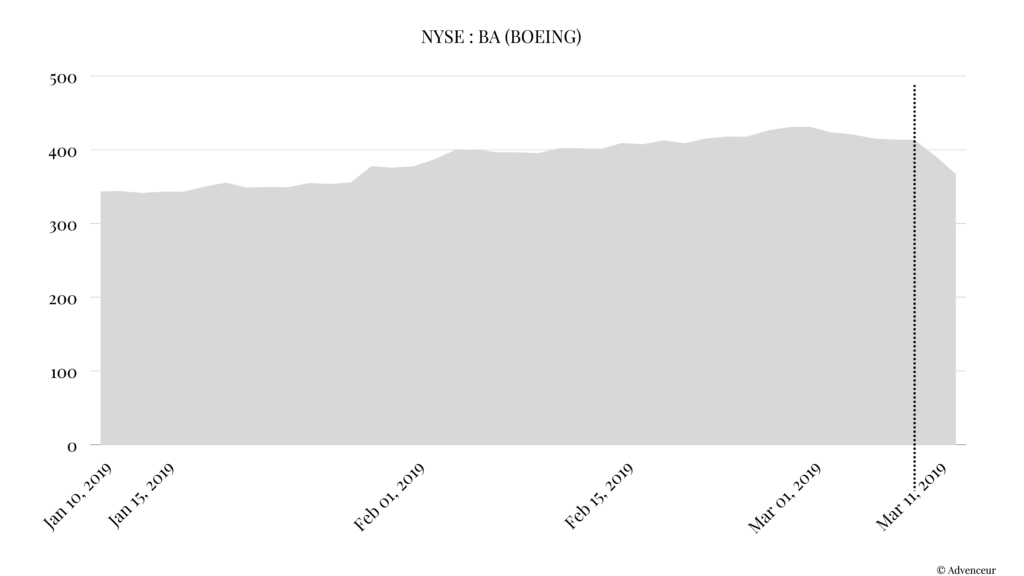
In the pursuit of profit, Boeing has changed its corporate culture and this has cost it dearly, both in terms of image and finances.
The Boeing Airline, an industry giant, originally rose to prominence through its corporate culture of producing the best quality possible. However, this corporate culture has turned into one that has negative consequences on the company.
In 2018 and 2019, two tragic accidents occurred during flights on the new Boeing 737 MAX. The documentary “Downfall” describes how these incidents are a direct consequence of the company’s mismanagement, including a corporate culture that favors profit over safety.
This example—of a company focused on performance, profit growth and economic warfare against its rival Airbus—shows how a good or bad corporate culture can change a company’s strategy, management and ultimately its value.
Overview
The documentary “Downfall” looks back at these tragic accidents, which occurred in an interval of less than five months on board new planes launched by the company in 2016, the 737 MAX. These planes are not new planes per se, they are a new version of the most produced model of airliner, at that time, the 737.
Boeing had not known in all its history such an event. In fact, the Seattle-based company, founded 1916, has been not only a pioneer, but also a leader in the world of aeronautics, aerospace and defense.
Starting in the 1990s, the corporate culture began to change as a result of mergers and the acquisition of competitors, as Boeing fought in a commercial struggle against Lockheed (a leader in the field of defense) and Airbus, (a European competitor that is gaining more and more market share since its birth in 1970).
However, in March 2019, there was a suspension of Boeing 737 MAX flights, either by government decree or by the will of the airlines. Hundreds of planes were grounded, and the bad publicity for Boeing was in full swing.
It is then the beginning of the investigations.
Study
Boeing is described by its employees at the time (until the mid-1990s), as a company where the corporate culture was conducive to their development and therefore a good working environment. The airline experienced sustained growth because of its focus on safety, and Boeing’s reputation for quality resulted in its market leadership.
The employees are immersed in a corporate culture comparable to that of Toyota (Lean management), where if one of the employees (regardless of rank) points out a defect in production and has it stopped to be noticed and repaired, he or she is praised. This goes hand in hand with the idea of the primacy of quality safety, but even from an economic point of view it has a positive impact, because improving this defect now will be cheaper than later, during a recall or an incident.
However, starting in the mid-1990s, as Airbus gradually gained market share from Boeing, and as it saw its efforts in the defense field not match the leader Lockheed, Boeing then merged and acquired competitors to “better” face this competition.
But, the problem was that the executives of these companies then took over Boeing. The corporate culture quickly changed to one focused on profit by increasing the value of the stock price. Its leaders were then focused on the stock price, which had to increase to generate profits for shareholders.
In 2001, Boeing moved its headquarters to Chicago, a financial center.
“When headquarters is located near a core business, as ours was in Seattle, the center of the company is inevitably drawn into the day-to-day business operations.”
Also, the president at the time, Harry Stonecipher, confessed:
“When people say I changed the culture of Boeing, that was the intention, to run it as a business rather than as a large engineering company.”
The employees quickly perceived a change in the culture from quality to profitability. The employees were no longer able to concern themselves with the quality of the product, because they were put under pressure to produce as quickly as possible under less favorable conditions. These employees had to produce more with less conditions than before.
The consequences on the safety and quality of the final products were then harmful. The assembly of these planes was done in a hurry and posed serious technical and safety problems.
From a competitive point of view, at the end of the 1980s until 1996, when Boeing and McDonnell Douglas merged, the Seattle-based company had on average twice as many orders as its European counterpart. However, after this merger, Airbus caught up and in the following years became the market leader.
Boeing vs Airbus

(In number of orders; Following the second 737 MAX accident, Boeing even had negative annual orders, i.e. more cancellations than new orders.)
Indeed, Airbus has relied more on a strategy of gaining market share, as with the A380 to compete with the 747 monopoly, rather than a strategy focused on pure profit. This can be explained by the fact that being a European company, and owned by governments (not just private actors), the culture of profit maximization is less prevalent.
According to Norm Dicks, “Mr. Boeing” of the House of Representatives of the state of Washington, where Boeing originates:
“In 2003, the value of Airbus orders was more than twice that of Boeing.”
Moreover, with these accidents, Boeing’s image, even before the discovery of what caused them, has deteriorated, which has obviously had an impact on the number of orders. Even though the company has grown historically because of its reliability and reputation for quality, that’s what they were lacking at the time, and the result was the opposite, a loss of market share.
Now, let’s go back to the connection between the incidents and this change in corporate culture.
These incidents occurred outside the United States. That was the company’s line of defense, and their CEO said that there were no problems with the design of their aircraft. These accidents were the fault of the airlines in question, notably due to poor pilot training.
However, during further investigations to determine the cause of these accidents, which could not be the result of chance, the design of the 737 Max was studied more closely. This aircraft had been updated in its design to compete with the Airbus a 320neo which had just launched a new version and was gaining a lot of market share.
The Boeing 737 had not been updated in terms of design for decades. The American company then decided to integrate new engines, larger, but also more efficient in their performance, in this old fuselage. But, with this 50 years old plane, Boeing wanted to launch it on the market in a few months to compete as quickly as possible with the new Airbus. Indeed, if they had created a new concept, better adapted to the new engines, they would have had to pass tests to certify the plane and that would have taken much more time.
The problem was that the engines were incompatible with the design, the structure of the aircraft, and could cause safety problems due to poor aerodynamics.
After tests which proved to be worrying, Boeing decided to set up a corrective system called MCAS. This system, integrated in the plane, took priority over the pilot’s controls. If the aircraft’s system sensed that the aircraft was unbalanced, it would attempt to right the aircraft and the pilot would have only a few seconds to regain control of the aircraft.
However, this new system was not known by the pilots, because even at the request of some of them, Boeing did not want to invest in this training.
In light of these revelations, and the priority of profit over the safety of Boeing products, the company proceeded to a sort of “guilty plea” to avoid trial. As a result of the flight suspensions and the consequences of these accidents, the company has made an annual financial loss. This loss varies according to the source, but is measured in billions of dollars. To this, we must add the indirect consequences in the long term such as the degradation of the image of the company and the cancellation of many orders. Its competitor Airbus then took advantage of this opportunity to gain more market share.
Moreover, the A320 has since become the best-selling airliner in the history of aviation. Boeing, rushing to counter this, finally helped its competitor.
By focusing on profits, Boeing neglected what had propelled it to the forefront, namely quality. As a result, the opposite of what it wanted happened, i.e. a negative impact on the value of the company, and therefore on the share price.
Stock market price affected by second accident

(Following the second 737 MAX accident, Boeing saw its stock drop more than 10% in just two days).
Opinion
It seems a bit simple as a message, through this concrete case, that if a company focuses only on profits (a bit of a cliché image of extreme capitalism), there will be negative consequences on the company and its value. However, this very specific case of one of the most important companies in the world, with such an important reputation, having had such a powerful negative impact by bad objectives, translated by a bad corporate culture, shows us how much the notion of corporate culture is essential in any entrepreneurial project.
The corporate culture is what will carry a project, because it is what will define internally what we want to convey as a message, as the DNA of the project. This corporate culture will define the strategy of the project, and it will also define the quality of work, or not, of its employees.
It is important to note that in this case, this bad strategy (focused on profit) is directly linked to the consequences of market loss (as well as human drama). In many cases, this link is not so tangible, so visible.
Conclusion
Corporate culture can sometimes seem like an abstract notion, rather vague, and sometimes even exaggerated in the management of a company. So in this case, we can see that corporate culture is a crucial point, at the very heart of an entrepreneurial project.
Unfortunately, this mismanagement of the Boeing company was revealed by these two accidents.
The development and success of this company have historically been based on safety. The corporate culture that prevailed was one of excellence, of putting the quality of their products above all else. As a result of mergers and acquisitions to increase their profits, a new corporate culture focused on this monetary aspect has totally transformed their priorities.
What is important to note here is that this has resulted in a loss of market share and therefore profits. If Boeing had continued in its historical corporate culture of creating value through quality, it would not have experienced its misdeeds, and would not have lost those billions of dollars.
The failure of Boeing in the last few years is due to this corporate culture, whereas the old corporate culture had allowed this same company to be so successful.
__________________________________________________________________________
Discover more:
